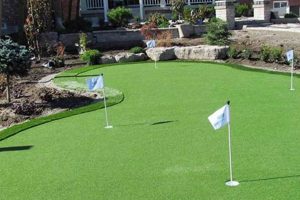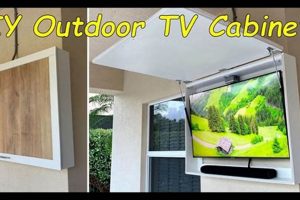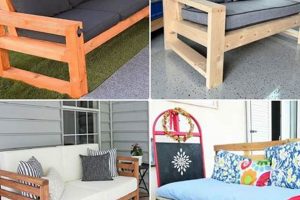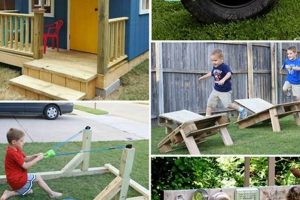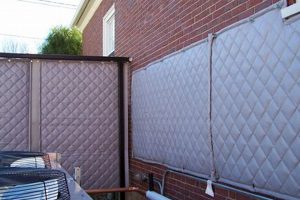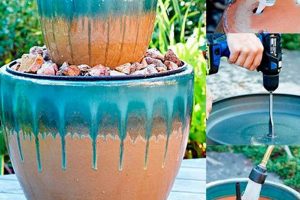The creation of personalized wooden seating, tables, and related pieces designed for use in exterior environments through individual effort is a growing trend. This encompasses a range of activities, from modifying existing items to constructing new pieces from raw lumber, often utilizing readily available plans and materials. Projects range from simple benches and planters to complex dining sets and lounge areas, each reflecting the builder’s individual skill and aesthetic preferences.
Constructing these items offers multiple advantages. It allows for customization to precisely fit specific spaces and personal tastes, often at a cost lower than purchasing comparable pre-made products. Furthermore, such projects offer opportunities for skill development, creative expression, and a tangible connection to the crafting process. Historically, woodworking has been a vital skill, and engaging in such activities fosters a sense of self-reliance and resourcefulness, while promoting sustainable practices by utilizing reclaimed or responsibly sourced wood.
The subsequent sections will delve into crucial aspects, including suitable wood selection, necessary tools and equipment, essential joinery techniques, effective finishing methods for weather resistance, and considerations for design and structural integrity to ensure longevity and safety. These elements are paramount to achieving successful and satisfying results.
Essential Considerations for Constructing Wooden Outdoor Furnishings
Successful construction of durable and aesthetically pleasing wooden items for exterior use requires careful planning and execution. The following tips outline critical aspects to consider throughout the building process.
Tip 1: Wood Selection is Paramount: Prioritize naturally rot-resistant species such as cedar, redwood, or teak. Alternatively, pressure-treated lumber offers protection, but exercise caution regarding potential chemical leaching and disposal.
Tip 2: Proper Joinery Ensures Structural Integrity: Utilize robust joinery techniques like mortise and tenon, dovetails, or pocket hole screws with exterior-grade adhesive to withstand the rigors of outdoor use. Avoid solely relying on nails or staples for load-bearing connections.
Tip 3: Precise Measurements and Cuts are Crucial: Accuracy in cutting and assembling components contributes to the overall stability and appearance of the finished piece. Double-check dimensions before each cut and employ accurate measuring tools.
Tip 4: Weather-Resistant Finishes are Essential: Apply multiple coats of exterior-grade sealant, paint, or stain to protect the wood from moisture, UV radiation, and temperature fluctuations. Reapply finishes periodically to maintain protection.
Tip 5: Consider Ergonomics and Comfort: Design furniture with comfortable seat heights, back angles, and armrest placement. Test prototypes or mock-ups to ensure ergonomic suitability.
Tip 6: Hardware Selection Matters: Opt for stainless steel or galvanized hardware to prevent rust and corrosion. Ensure screws and bolts are appropriately sized and tightened securely.
Tip 7: Prioritize Proper Drainage: Design furniture to allow water to drain freely. Angled surfaces and gaps between boards prevent water accumulation, minimizing rot and decay.
Implementing these guidelines will contribute significantly to the longevity, safety, and visual appeal of custom-built wooden exterior furnishings.
The following sections will provide more in-depth guidance for successful project completion.
1. Wood Selection
The selection of appropriate wood species is a foundational element in the successful construction of outdoor furniture. The inherent properties of different wood types directly impact the furniture’s resistance to environmental factors, including moisture, sunlight, and insect infestation. For instance, using a non-durable wood like pine without extensive treatment will invariably lead to premature decay when exposed to the elements, negating the time and effort invested in construction. Conversely, naturally rot-resistant woods like cedar, redwood, or teak offer inherent protection, extending the lifespan of the furniture with minimal chemical intervention. The choice thus represents a critical initial decision, directly affecting the long-term viability of the project.
Consider the example of a handcrafted Adirondack chair. If constructed from untreated softwood, it may only last a few seasons before showing signs of rot and structural weakening. However, if the same design is executed using sustainably harvested teak, the chair could withstand decades of exposure with only minimal maintenance, developing a desirable patina over time. This highlights the economic and environmental benefits of investing in appropriate materials from the outset. Furthermore, the type of wood also impacts the finishing process. Some woods accept stains and paints more readily than others, influencing the final aesthetic outcome of the furniture. Selecting the correct material is not merely a matter of cost; it’s an investment in longevity, aesthetics, and sustainability.
In summary, wood selection forms the bedrock upon which durable and aesthetically pleasing outdoor furniture is built. Neglecting this aspect increases the likelihood of premature failure, while informed material choices contribute to a lasting and sustainable outcome. Understanding the properties of different wood species, including their resistance to rot, insects, and weathering, is therefore paramount to ensuring the success of these projects. The choice ultimately determines the balance between initial cost, long-term durability, and overall aesthetic satisfaction, aligning the project with both functional and environmental goals.
2. Joint Strength
Joint strength represents a critical factor in the design and construction of wooden items intended for outdoor use. The integrity of the joinery directly correlates with the furniture’s ability to withstand environmental stresses and applied loads, ensuring longevity and safety. Inadequate joint strength can lead to premature failure, rendering the piece unusable and potentially hazardous.
- Mortise and Tenon Joints
The mortise and tenon joint provides exceptional strength and stability due to its mechanical interlocking. A tenon (projection) fits precisely into a mortise (hole), creating a robust connection suitable for chair legs, table frames, and other load-bearing components. Variations such as wedged or pinned mortise and tenon joints further enhance their resistance to separation under stress. For example, a dining table constructed with mortise and tenon joints in the legs and aprons is far more likely to remain stable and durable over time compared to one assembled with weaker jointing methods.
- Dovetail Joints
Dovetail joints are known for their exceptional tensile strength, resisting pulling forces. The interlocking, fan-shaped “tails” and “pins” create a mechanical lock that prevents the joint from separating. While visually appealing and indicative of craftsmanship, dovetails are more commonly employed in drawer construction and less frequently used in primary structural joints of outdoor furniture due to the complexity of their execution. However, adapted forms can contribute to corner bracing and decorative elements where tensile strength is beneficial.
- Pocket Hole Joinery with Exterior-Grade Fasteners
Pocket hole joinery, utilizing angled screws inserted into pre-drilled holes, offers a relatively quick and accessible method for creating strong connections. When combined with exterior-grade screws and adhesives designed for outdoor applications, this method can provide adequate strength for certain furniture components, such as table tops or bench seats. However, it’s crucial to recognize that pocket hole joints are generally less resistant to racking forces (side-to-side movement) compared to traditional joinery techniques like mortise and tenon. Therefore, reinforcement with corner braces or additional support structures may be necessary to ensure long-term stability.
- Lap Joints with Robust Fasteners
Lap joints, where two pieces of wood overlap and are fastened together, represent a simple yet effective jointing method. The strength of a lap joint depends heavily on the type and placement of fasteners. Exterior-grade screws, bolts, and adhesives are essential for resisting corrosion and maintaining structural integrity in outdoor environments. Strategically placed fasteners and adequate surface area within the lap joint contribute to improved load-bearing capacity. For example, lap joints are often used in the construction of picnic table benches or simple frame structures, where the overlapping surfaces provide a secure platform for fasteners to create a strong connection.
The selection and execution of appropriate joinery techniques directly impacts the structural integrity and service life. Choosing weaker joinery methods can lead to instability, while employing stronger, more durable methods guarantees long-term durability. Therefore, understanding the strengths and limitations of various jointing techniques is crucial for successful outdoor furniture construction.
3. Weather Protection
Weather protection is an indispensable element in the construction of wooden furnishings designed for outdoor environments. Prolonged exposure to environmental elements such as moisture, sunlight (UV radiation), and fluctuating temperatures can initiate and accelerate the degradation of wood, compromising its structural integrity and aesthetic appeal. The absence of effective weather protection measures directly leads to warping, cracking, rot, fungal growth, and discoloration, significantly reducing the lifespan of the furniture. A picnic table left untreated, for instance, may exhibit signs of decay within a single season, while a properly protected one can endure for many years. This illustrates the direct cause-and-effect relationship between weather protection and the longevity of such projects.
The application of weather-resistant finishes forms the primary defense against environmental damage. These finishes, including paints, stains, sealants, and varnishes, create a barrier that inhibits moisture absorption, reflects UV radiation, and resists temperature-induced expansion and contraction. The selection of an appropriate finish depends on factors such as the wood species, desired aesthetic, and level of exposure to the elements. For example, a spar varnish is often chosen for marine applications due to its flexibility and resistance to water penetration, qualities equally beneficial for outdoor furniture in persistently damp climates. Similarly, UV-resistant pigments incorporated into stains and paints help prevent fading and discoloration caused by sunlight. Regular maintenance, involving periodic reapplication of finishes, is also crucial for maintaining the protective barrier and extending the furniture’s lifespan. Ignoring this maintenance allows the protective layer to degrade, leaving the wood vulnerable to the elements.
In summary, weather protection is a non-negotiable aspect of wooden outdoor furniture construction. Failure to adequately address this factor results in premature deterioration and diminished functionality. The implementation of appropriate finishing techniques, coupled with consistent maintenance practices, ensures that wooden pieces can withstand the rigors of the outdoor environment, preserving their structural integrity, aesthetic value, and overall longevity. Therefore, a thorough understanding of weather protection principles and methods is crucial for the successful creation and preservation of such furniture, aligning practical construction with long-term environmental resilience.
4. Design Ergonomics
The application of ergonomic principles is critical in the design and construction of wooden outdoor furniture. Ergonomics focuses on optimizing the interaction between humans and their environment to reduce discomfort and injury while maximizing efficiency and enjoyment. When applied to outdoor furniture, it directly impacts the user experience, influencing comfort, posture, and overall well-being.
- Seat Height and Depth
Appropriate seat height and depth are fundamental to comfortable seating. A seat height that is too low can strain the knees and back during sitting and standing, while a height that is too high may restrict circulation. Similarly, excessive seat depth can prevent proper back support, leading to slouching and discomfort. In the context of handcrafted outdoor furniture, careful consideration of these dimensions, tailored to the intended user’s average height, is crucial. For example, a dining chair typically requires a higher seat height than a lounge chair to facilitate comfortable dining posture. Precise measurements and mock-ups are advisable to ensure optimal comfort.
- Back Support and Lumbar Curve
Adequate back support, particularly in the lumbar region, is essential for maintaining proper spinal alignment and preventing back pain. Outdoor furniture designs should incorporate features that support the natural curvature of the lower back. This can be achieved through curved backrests, adjustable lumbar supports, or strategically placed cushions. The design of an Adirondack chair, for instance, often includes a contoured back that provides support to the lumbar region. When constructing this or similar pieces, paying meticulous attention to the curvature and angle of the backrest ensures a comfortable and supportive seating experience.
- Armrest Height and Placement
Correct armrest height and placement contribute significantly to upper body comfort and relaxation. Armrests that are too high can cause shoulder strain, while those that are too low offer inadequate support. The ideal height allows the user to rest their arms comfortably without hunching or shrugging their shoulders. Furthermore, the placement of armrests should allow for easy entry and exit from the furniture. In designs for handcrafted outdoor furniture, consideration of armrest height, width, and angle, relative to the seat height and backrest, is paramount. Trial and error, guided by ergonomic principles, can help determine the optimal configuration for user comfort.
- Material and Surface Comfort
The choice of materials and surface finishes directly influences the tactile comfort of wooden outdoor furniture. Smooth, well-sanded surfaces prevent splinters and skin irritation, while appropriately chosen cushions or padding can enhance comfort during prolonged use. Wood species with naturally smooth textures, such as cedar or teak, can minimize the need for extensive sanding. Furthermore, the application of breathable, water-resistant finishes prevents moisture buildup and maintains a comfortable surface temperature. In the creation process, attention to detail in material selection and finishing techniques ensures a pleasant and inviting seating experience.
These ergonomic considerations are intrinsically linked to the creation of functional and comfortable handcrafted wooden outdoor furniture. A failure to address these factors can result in furniture that is aesthetically pleasing but ultimately uncomfortable or even detrimental to the user’s health. Therefore, incorporating ergonomic principles into the design and construction process is crucial for creating outdoor pieces that are both visually appealing and ergonomically sound.
5. Hardware Durability
The durability of hardware components represents a critical determinant of the longevity and structural integrity of custom-built wooden outdoor furniture. Corrosion, material fatigue, and mechanical failure of fasteners and connecting elements directly undermine the furniture’s ability to withstand environmental stresses and applied loads. Inferior hardware choices ultimately lead to premature deterioration and compromised safety, necessitating costly repairs or complete replacement. For instance, the use of standard steel screws in an outdoor bench will inevitably result in rust formation, weakening the joints and potentially causing the wood to split as the corrosion expands. The selection of appropriate, durable hardware, therefore, is not merely a supplementary consideration but a foundational requirement for constructing reliable outdoor pieces.
Specific examples underscore the practical significance of this principle. Stainless steel fasteners, known for their resistance to corrosion in damp environments, are frequently employed in marine applications and are equally suitable for outdoor furniture construction. Similarly, galvanized steel offers a cost-effective alternative, providing a protective zinc coating that retards rust formation. Bolts and screws should be appropriately sized and graded to withstand anticipated loads; using undersized fasteners in a structural joint can lead to shear failure under stress. Furthermore, hinges, latches, and other moving parts must be constructed from durable materials and designed for smooth operation even after prolonged exposure to the elements. Neglecting these details compromises the functionality and safety of the furniture, creating potential hazards for users.
In summary, hardware durability is inextricably linked to the overall performance and lifespan of wooden outdoor furniture. The selection of corrosion-resistant materials, appropriately sized fasteners, and robust moving parts is essential for ensuring structural integrity and user safety. Ignoring these considerations compromises the investment in materials and labor, leading to premature failure and potentially hazardous conditions. By prioritizing hardware durability, builders can significantly extend the service life of their creations, contributing to both economic value and environmental sustainability.
6. Drainage System
Efficient water drainage is a critical yet often overlooked aspect in the design and construction of wooden pieces intended for outdoor use. The accumulation of moisture within the structure accelerates wood decay, promotes fungal growth, and weakens joints, significantly reducing the furniture’s lifespan. Without adequate drainage provisions, even naturally rot-resistant woods are susceptible to deterioration. The absence of effective drainage acts as a primary catalyst for structural compromise, transforming durable outdoor pieces into short-lived liabilities. For instance, a wooden bench with a solid, flat seat will collect rainwater, creating a perpetually damp environment that fosters rot, whereas the same bench designed with gaps between the slats permits water to escape, mitigating moisture damage and prolonging its usability.
Practical application of drainage principles involves several key design considerations. Angled surfaces allow water to run off readily, preventing pooling. Gaps between boards or slats provide pathways for water to drain, minimizing prolonged contact with the wood. Adequate spacing between the furniture and the ground prevents moisture absorption from the soil. Furthermore, the inclusion of drainage holes in enclosed structures, such as planters or storage boxes, ensures that water does not accumulate internally. A well-executed drainage system complements the protective effects of weather-resistant finishes, providing a comprehensive defense against moisture-related damage. Ignoring this element compromises the effectiveness of other protective measures, rendering them less impactful in the long term.
The implementation of a robust drainage strategy presents a straightforward solution to a significant challenge in outdoor furniture construction. By prioritizing drainage in the design phase and incorporating practical features that facilitate water runoff, builders can substantially enhance the durability and longevity of their creations. A comprehensive approach to water management, encompassing both material selection and drainage system design, represents a crucial investment in the sustained performance and aesthetic appeal of wooden outdoor furnishings. The understanding and application of drainage principles contribute directly to the creation of pieces that are both functional and resilient in the face of environmental pressures.
Frequently Asked Questions
This section addresses common inquiries regarding the construction of wooden furniture for outdoor use. The following questions and answers aim to provide clarity and guidance on key aspects of the process.
Question 1: What are the most suitable wood species for outdoor furniture projects?
Naturally rot-resistant woods, such as cedar, redwood, and teak, offer superior durability and longevity when exposed to the elements. Pressure-treated lumber provides a cost-effective alternative, but potential chemical leaching should be considered. Untreated softwoods are generally unsuitable for outdoor use without extensive protective coatings.
Question 2: What types of joinery techniques are recommended for ensuring structural integrity?
Mortise and tenon joints, dovetail joints, and robust lap joints provide exceptional strength and stability. Pocket hole joinery, when combined with exterior-grade fasteners and adhesives, can be suitable for certain applications. Avoid relying solely on nails or staples for load-bearing connections.
Question 3: How can the wood be effectively protected from weather damage?
Application of multiple coats of exterior-grade sealant, paint, or stain protects the wood from moisture, UV radiation, and temperature fluctuations. Regular maintenance, including periodic reapplication of finishes, is crucial for maintaining the protective barrier.
Question 4: What hardware materials are best suited for outdoor use?
Stainless steel and galvanized steel hardware resist rust and corrosion. Ensure that screws, bolts, and other fasteners are appropriately sized and graded for the intended load-bearing capacity.
Question 5: How can the design be optimized for proper water drainage?
Incorporate angled surfaces, gaps between boards, and drainage holes to facilitate water runoff and prevent moisture accumulation. Ensure adequate spacing between the furniture and the ground to minimize moisture absorption from the soil.
Question 6: Are there specific safety precautions to observe during construction?
Always wear appropriate personal protective equipment, including safety glasses, gloves, and a dust mask. Utilize power tools safely and follow manufacturer instructions. Work in a well-ventilated area to avoid exposure to harmful fumes from wood preservatives and finishes.
These FAQs highlight fundamental considerations for those undertaking the creation of wooden outdoor furniture. A thorough understanding of these principles contributes significantly to the successful completion of durable and aesthetically pleasing projects.
The following section will explore advanced techniques.
Conclusion
This exposition has detailed critical considerations for the successful creation of “diy wood outdoor furniture.” Emphasis has been placed on material selection, joinery methods, protective finishes, and hardware choices as essential elements impacting longevity and structural integrity. Furthermore, the importance of ergonomic design and effective drainage systems has been underscored to ensure both user comfort and resistance to environmental degradation.
The construction of durable and aesthetically pleasing exterior furnishings demands a meticulous approach to both design and execution. Further exploration and adherence to established best practices are encouraged to maximize the lifespan and utility of these handcrafted pieces. The long-term value derived from these endeavors directly correlates with the dedication to sound building principles and sustainable material choices.


